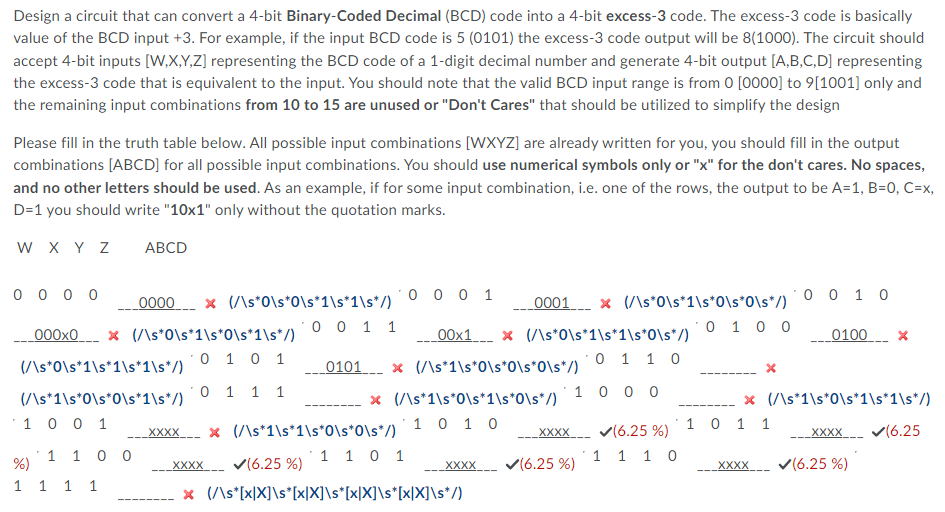Home /
Expert Answers /
Electrical Engineering /
design-a-circuit-that-can-convert-a-4-bit-binary-coded-decimal-bcd-code-into-a-4-bit-excess-3-co-pa430
(Solved): Design a circuit that can convert a 4-bit Binary-Coded Decimal (BCD) code into a 4-bit excess-3 co ...
Design a circuit that can convert a 4-bit Binary-Coded Decimal (BCD) code into a 4-bit excess-3 code. The excess-3 code is basically value of the BCD input +3. For example, if the input BCD code is 5 (0101) the excess-3 code output will be 8(1000). The circuit should accept 4-bit inputs [W,X,Y,Z] representing the BCD code of a 1-digit decimal number and generate 4-bit output (A,B,C,D) representing the excess-3 code that is equivalent to the input. You should note that the valid BCD input range is from 0 [0000] to 9[1001] only and the remaining input combinations from 10 to 15 are unused or "Don't Cares" that should be utilized to simplify the design Please fill in the truth table below. All possible input combinations [WXYZ] are already written for you, you should fill in the output combinations (ABCD] for all possible input combinations. You should use numerical symbols only or "x" for the don't cares. No spaces, and no other letters should be used. As an example, if for some input combination, i.e. one of the rows, the output to be A=1, B=0, C=x, D=1 you should write "10x1" only without the quotation marks. W X Y Z ABCD X 0 0 0 0 0000 * (/\s*0\s*0\s*1\s*1\s*/) 0 0 0 1 0001 * (/\s*0\s*1\s*0\s*0\s*/) 0 0 1 0 000x0 * (/\s*0\s*1\s*0\s*1\s*/) 0 0 1 1 00x1___ * (/\s*0\s*1\s*1\s*0\s*) 'O 100 0100 (/\s*0\s*1\s*1\s*1\s*/) 0 1 0 1 0101_ _ * (/\s*1\s*0\s*0\s*0\s*/) 0 1 1 0 (/\s*1\s*0\s*0\s*1\s*/) 0 1 1 1 * (/\s*1\s*0\s*1\s*0\s*/)' 1 000 * (/\s*1\s*0\s*1\s*1\s*/) 1 0 0 1 x (/\s*1\s*1\s*0\s*0\s*/) 1 0 1 0 (6.25 %) 1 0 1 1 (6.25 1 1 0 0 %) (6.25 %) 1 1 0 1 1 1 1 0 (6.25 %) (6.25%) 1 1 1 1 x (/\s*[x|X]\s*[x[X]\s*[x|X] \s*[x[X]\s*/) XXXX XXXX XXXX XXXX XXXX XXXX --------
